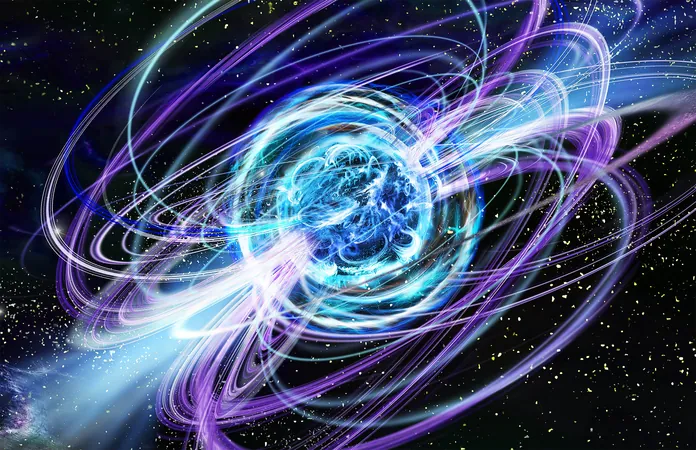
Astounding Discovery: Magnetar Flares Causing Gold and Platinum Formation in Space!
2025-05-04
Author: Ying
A Cosmic Treasure Trove: New Insights into Element Production
In a groundbreaking revelation, scientists have discovered that intense magnetar flares in space are responsible for producing enormous amounts of coveted metals like gold and platinum. This astonishing finding challenges our long-held beliefs about the origins of these precious elements.
What Are Magnetars?
Magnetars are the universe's most magnetic entities, formed from the explosive deaths of massive stars. With mass greater than our sun compacted into a mere dozen miles, their magnetic fields are a staggering thousand times stronger than typical neutron stars—trillions of times more powerful than anything on Earth!
The Role of Magnetar Flares
These extraordinary cosmic occurrences, which emit intense bursts of X-rays and gamma rays, can have ripple effects that reach Earth from distances of thousands of light-years. Recent studies show that a single flare can forge up to two million billion billion kilograms of heavy atoms.
Element Factories in Space
Researchers are unveiling that these flares may account for about 10% of the precious metals in our galaxy. Each magnetar flare acts like a cosmic factory, creating heavier elements in seconds by colliding neutrons with lighter ones, leading to an explosion of fundamental materials.
Unlocking the Universe's Metal Supply
Brian Metzger from the Flatiron Institute explains, "This discovery marks only the second time we've directly observed how these elements form, deepening our understanding of heavy element production in the universe." Beyond gold and platinum, materials like uranium also emerge from this r-process, showcasing how these stellar events are pivotal in enriching cosmic chemistry.
A New Chapter in Stellar Dynamics
Before this revelation, scientists believed supernova explosions and neutron star mergers were the primary sources of heavy elements. While these events remain crucial, magnetar flares introduce an exciting new variable. Their energetic jets propel newly created metals into space, helping to seed future star systems and planets.
Anticipating Future Magnetar Events
Astronomers are eager to capture future magnetar eruptions, which provide unique insights into nuclear reactions. Upcoming missions, such as NASA's Compton Spectrometer and Imager set to launch in 2027, aim to track the fleeting signals emitted by these fascinating cosmic phenomena.
The Golden Legacy of Magnetars
This discovery reshapes our understanding of how heavy elements form in the early universe, suggesting magnetars may contribute to cosmic metal supplies sooner than previously believed. Just imagine: the metals in your phone could very well have originated from a magnetar’s explosive outburst!
A Bright Future for Cosmic Research
As scientists wait for the next magnetar flare, the potential to witness real-time nuclear reactions becomes increasingly plausible. The race to capture these flashes is on, and as telescopes become sharper, the likelihood of uncovering more of space’s secrets grows.
These riveting findings were detailed in The Astrophysical Journal Letters, signaling a new era in our understanding of the universe's complex and fascinating origins.




 Brasil (PT)
Brasil (PT)
 Canada (EN)
Canada (EN)
 Chile (ES)
Chile (ES)
 Česko (CS)
Česko (CS)
 대한민국 (KO)
대한민국 (KO)
 España (ES)
España (ES)
 France (FR)
France (FR)
 Hong Kong (EN)
Hong Kong (EN)
 Italia (IT)
Italia (IT)
 日本 (JA)
日本 (JA)
 Magyarország (HU)
Magyarország (HU)
 Norge (NO)
Norge (NO)
 Polska (PL)
Polska (PL)
 Schweiz (DE)
Schweiz (DE)
 Singapore (EN)
Singapore (EN)
 Sverige (SV)
Sverige (SV)
 Suomi (FI)
Suomi (FI)
 Türkiye (TR)
Türkiye (TR)
 الإمارات العربية المتحدة (AR)
الإمارات العربية المتحدة (AR)